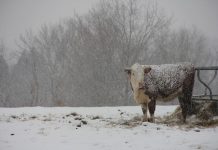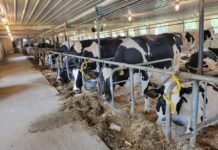2010 … It has been a “dickens” of a year! The challenge of the American job market has loomed in blogs, coffee shop conversations and in every form of printed material. It can even be likened to the plot of the classic Charles Dickens tale, A Christmas Carol.
It seems that our country is haunted by the ghosts and bondage of the past, surrounded by the conditions of the present, and yet hopeful for future outcomes. Can our ending be scripted showing the new and improved version of Ebenezer Scrooge?
Considering my emphasis on the next generation, I have been collecting some very positive information about the career outlook for kids who will focus their studies in agriculture, whether their roots are from the farm or elsewhere. Jobs are in many places, but discovering a career that can sustain our spirits and a checkbook is the ultimate reward.
It should come as no surprise that agriculture is at a critical juncture. The average age of the U.S. farmer is 57 years and rising. Yet fewer people are choosing production agriculture as a vocation.
According to USDA Secretary Tom Vilsack, as reported in Farm Journal, there was a 30 percent increase in farmers over the age of 75 and a 20 percent decrease in farmers under 25. Such a trend is going to require a more aggressive approach.
Efforts
Many organizations are stepping up to educate young farmers on how to manage opportunity and risk through educational efforts, and others are offering monetary grants and debt forgiveness on college loans. These efforts are geared to make it possible for youth to return to the farm when the timing is right and even to help offset the shortage of large animal veterinarians in some areas.
On the other hand, graduates with food, agriculture and environmental science degrees are tempted by the salaries and benefits that businesses can offer them. They may have grown up watching parents work hard with little free time. Perhaps we need to remember that these students cannot remember a time when a computer was not a part of their lives.
Mike Gaul, director for the College of Agriculture and Life Sciences career services at Iowa State, responds with this insight, “The limiting factor is that their parents aren’t quite ready for many of our recent graduates. They are mid to upper Baby Boomers who aren’t retirement age. Young adults see high risk, hard manual labor, lock of land and high inputs as turn offs.”
As I reflect on the fact that there is a 20 percent decrease in farmers under 25, it makes me wonder if these individuals are waiting on parents to invite them and maybe also give them extra time to test their career focus. In the meantime, they are picking up valuable skills by working for other businesses and perhaps saving some money for the next phase of their lives.
Demand
With the nationwide unemployment rate stuck at 9 percent or more, it is interesting to report that graduates in food, agriculture, and environmental sciences are in demand, according to Marcos Fernandez in Penn State’s College of Agricultural Sciences.
Citing a recently released study by USDA, this dean for undergraduate education noted that about 54,400 annual openings will be available for these individuals between 2010 and 2015. However, he points out there will only be enough of these ag and natural resource graduates to fill 54 percent of those open positions.
The study suggests that although employers have expressed a preference for those in this area, they may be forced to turn to graduates in the allied fields, such as biological and health sciences, engineering, and business and communications to fill the remaining openings.
Factors
Major factors influencing the job market for graduates during the five-year period will include overall economic conditions, retirements, consumer preferences for nutritious and safe foods, energy and environmental public-policy choices and global market shifts in population, income, food and energy.
Fernandez believes education and training in our food, agriculture, natural-resource and related sciences are as critical today as they ever have been.
“Experts forecast a 50 percent growth in the world’s population to about 9 billion in the next 40 years,” he said. “That increase will require a doubling in food production!”
After reading this fact, I would like to add that the goal must be achieved in a way the general public finds acceptable. This is a daunting task for those who will follow in our footsteps. With these prospects for career openings, we can look to our own Ohio State University for facts and figures in the College of Food, Agriculture and Environmental Science.
Challenge
According to Mariette Benage, academic planning specialist and student success coordinator, our college has a 92 percent placement rate upon graduation, one of the highest in the nation. She feels that one of the struggles here and across the country is that students aren’t willing to go out of state if that is where the opportunities are.
In addition, students are not as willing to start at the bottom and work their way up; they feel entitled to management positions with greater pay. The reality is that it is so expensive to get an education anymore; it is difficult to start out at $30-35,000 and balance a checkbook.
As enrollment numbers have increased in the nation’s colleges of agriculture by almost 22 percent from 2005 to 2008, there are curriculum challenges and changes that will need to take place in order to prepare students for the workforce.
Even though this is an ongoing process at all schools, there is a hope that we can target the proper formula to keep pace with the changes that will or might take place. There are scores of solid four-year agricultural programs in colleges and universities across the country, all working to develop curriculum that includes learning in the traditional classroom as well as outside in the work force.
Options
Internships have certainly been an important and valuable inclusion for students. It is interesting to note in 2009, The Ohio State University (Robert J. Birkenholz and Jon C. Simonsen) conducted a study asking professionals to rank agriculture education-oriented programs.
OSU was ranked third, with the University of Florida in the top spot followed by Texas A&M. For more results on this study, click on the following link, www.aaaeonline.org/files/national_09/papers/22.pdf.
According to AgCareers.com, a North Carolina based website, ag industry positions have shown a 30 percent increase in the past year. Maybe the focus of this article could also include those people who have lost jobs in other vocations or left production agriculture for all the same temptations that our graduates find appealing if they are waiting to return to the family farm?
Eric Spell, president of Ag Careers.com believes a few things have changed with trends. “We’re still in the business of producing foods; the world needs more than ever. To produce and get more efficient, the ag industry is afforded some opportunities.”
Valuable experience
As I interact with employers, especially those who have had interns, they feel our traditional farm kids are desirable because of their hands-on knowledge about the industry and the fact their work ethic was fostered by growing up with farm chores and responsibilities. Perhaps our best farm product is still our kids.
4-H and FFA take it one step further by encouraging those NOT from a rural background to also sample agriculture through projects and science based curriculum. From these roots, they are encouraged to select a course of studies in our College of Food Agriculture and Environmental Sciences at Ohio State. The variety of focus and curriculum offered to them is both intriguing and appealing.
Outlook
Just as Scrooge must find himself in the Dickens story, so must we seek out what new revelations the next generation will carve their initials on. With the background provided here, I have the utmost confidence that our story will end just as hopeful.
It is said that life can only be understood backwards; but it must be lived forwards. Bless us all as we reflect on what 2010 has offered and what 2011 will bring forward!
(Bonnie Ayars is a dairy program specialist at Ohio State University. Questions or comments can be sent in care of Farm and Dairy, P.O. Box 38, Salem, OH 44460.)












